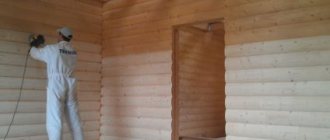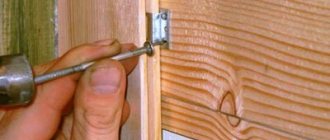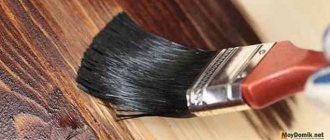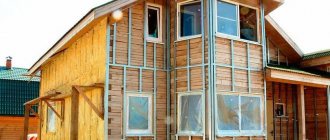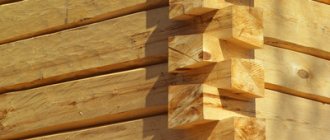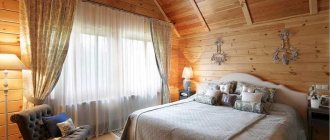The construction of a country cottage from timber begins with laying the foundation and erecting walls. They are followed by equally important stages, one of which, the finishing of the house, directly affects not only the aesthetics, but also the durability of the building. Most homeowners prefer to preserve the natural beauty of wood inside the house without covering the walls with finishing material. The finishing of residential premises is preceded by grinding the timber inside the house, a mandatory procedure with its own technological rules and subtleties.
Natural beauty of timber walls in the interior of a country house Source beton-cement-ru.ru
When is wall sanding done?
Sanding is the process of treating a wooden surface before finishing, painting or varnishing. Sanding removes defects and makes the wood smooth, allowing you to achieve an even paint layer; it is used in the following cases:
- When building a new house . Sanding walls made of timber is done by waiting for the timber to dry, after the building has settled. During the work, irregularities that appear after the wood has dried are eliminated; work can be carried out at any time of the year.
- During the restoration of an old house . This grinding renews the color of the timber walls, after which they are re-coated with paint and varnish.
Walls are polished during the construction of a house and periodically during operation Source drevogid.com
Why do internal timber walls need to be sanded?
Sanding timber walls inside the house solves several problems:
- Prepares the surface for painting . Before construction begins, any wooden material is treated with an antiseptic and fire retardant. Since most antiseptics are water-based, after getting wet and drying, the wooden wall becomes covered with lint. Sanding removes lint and simultaneously levels the wall, some of the crowns of which may protrude above the surface (sometimes by 1-2 mm). Smooth walls mean easier painting and savings on materials, which can be a noticeable amount if the house is large and the paint is high-quality.
- Emphasizes the beauty of wood . During operation, coatings become obsolete, so wooden walls require periodic treatment. Sanding removes the old paint layer and reveals the texture of natural wood.
- Extends the life of the house . Protective impregnations are absorbed deeper into the newly sanded wooden surface. This is especially true for buildings with irregular winter heating.
Walls made of timber often need tone equalization Source indeco.ru
See also: Catalog of construction companies that have a full production cycle
Peculiarities
This process solves several problems:
- removal of mold and mildew stains;
- elimination of minor damage to timber received during installation;
- lightening the wood surface;
- removing lint after using antiseptic impregnations;
- giving freshness to the pattern and texture of wood.
We invite you to familiarize yourself with Cleaning products for composite pools. Polishing also involves the removal of a layer damaged as a result of external influences, renewal after several years of operation of the premises. In addition, this removes old varnish and antiseptic impregnation from the surface, which are no longer relevant. Sanding helps restore the timber to the look and color of fresh wood.
The process of building a house from any material is always very labor-intensive and includes several steps.
Sanding is one of the important stages of finishing logs, allowing you to protect the wood from such factors as:
- rotting;
- the appearance of mold and fungi that destroy natural building materials;
- darkening;
- uneven logs;
- exposure to moisture and insects.
It is worth noting that sanding is needed regardless of the type of log. Thus, rounded and chopped logs must be sanded, despite the aesthetic and presentable original appearance.
Sanding a log frame has the following advantages:
- additional material protection;
- improving the penetration of antiseptics and paints into logs;
- savings in paint and varnish consumption;
- removing dirt from wood that invariably accompanies transportation.
And yet, some unscrupulous craftsmen neglect grinding, because this process is quite labor-intensive, time-consuming and energy-consuming. In addition, it can be carried out only after complete shrinkage of the logs, which on average ranges from six months to a year, depending on the type of structure. You can reduce time costs by purchasing laminated veneer lumber, which is thoroughly dried during the manufacturing process, so it practically does not shrink. Sanding wet wood will certainly cause scuffing and damage.
So, having decided to build a house according to all the rules, you should refuse tempting offers to build turnkey log houses. As a rule, they are not aimed at long-term quality, but at speed of implementation, which, one way or another, affects unpleasant surprises during the operation of the building. And you shouldn’t skimp on the services of professional log sanding craftsmen, because it requires not only the proper skills, but also special tools and means to protect your health.
Grinding: tools and equipment
When choosing how and with what to sand the timber before painting, pay attention to the speed and quality of the process, which depends on the choice of method and tools. If you sand walls made of profiled timber by hand, using sandpaper, you will have to spend several weeks at work, surrounded by a cloud of wood dust. It is much more convenient to process all surfaces with a grinding machine, and use sandpaper only in places that are difficult for the tool to reach. Grinding is carried out in the presence of the following components:
- Sanding machine with sandpaper of various grits. Some models are connected to a vacuum cleaner, which significantly reduces the amount of dust. The abrasive wheel is selected depending on the type of wood.
- Angle grinder (angle grinder, grinder ). It comes with a set of abrasive discs with different parameters for rough and fine grinding.
A professional tool will ensure high-quality surface leveling Source ar.aviarydecor.com
- Sandpaper with different concentrations of abrasive. It is selected depending on the condition of the walls. At the initial stage, unevenness is removed with paper numbered 40-60, the old paintwork is removed with sandpaper 100-140. Lint removal will require the use of numbers 160-220. At the final stage (polishing) a grit size of 90-120 is used.
- Protection . To prevent fine, ubiquitous dust from penetrating the respiratory system and damaging your eyes, you should stock up on a respirator and safety glasses.
- Construction vacuum cleaner . Without careful dust removal, you can forget about high-quality processing and painting.
- Assistive devices . You will need a stepladder (or its substitute), an extension, a chisel and a sanding sponge with cut corners (for better access to corners).
A respirator and glasses are an indispensable component of equipment Source pinterest.pt
What does the tool kit consist of?
In fact, there are not so many of them, since convenient tools have been created and they are constantly used. Let's look at the most popular:
The easiest way to work is with a specialized angle grinder or the capabilities of a modern angle grinder, which has a set of suitable versions of attachments such as grinding rounds of various sizes.
High-quality grinding of timber with your own hands is carried out using grinders of various types, for which coarse abrasive attachments numbered 30-60 are used.
The fine grinding process is carried out with a variety of attachments with a small grain type. The angled version of the sanding machine shows the best performance during the process of processing the interior of walls based on planed logs.
It is convenient to work with profiled timber based on the capabilities of the belt model of the sanding machine. To do this, it has a rotating belt-type version of the abrasive surface. With its help, the process of getting rid of the old varnish coating is simplified.
An increased level of functionality is provided by the length of the blade. It is recommended to use a belt with a length of 610 mm, as it is considered the optimal version of the tool for sanding the largest surface areas of timber.
Almost all models are offered with a container for collecting and disposing of chips, dust and other residues, which helps save valuable minutes during the cleaning process.
The inside of timber premises can be sanded using a vibratory grinding machine model, which has a rectangular version of the working sole.
Such equipment is distinguished by its increased quality of grinding, and therefore is used for the final stage of working with the surface of the timber.
We are talking about fine and polishing processing. Based on a triangular shape, such a product helps to polish hard-to-reach places such as corners or grooves of a log house.
- Soil resistance - a practical guide on how to determine the main parameter (75 photos)
Insulation of facades - selection of materials and instructions for creating ventilated facades (85 photos)
Self-priming pump - 120 photos of the best models and their main characteristics
Profiled and laminated timber: differences in the process
Sanding allows you to improve the appearance of walls and prepare them for high-quality painting, waxing or varnishing. For profiled and glued material, the process is different:
- Profiled timber . Usually processed in two steps. The first time is sanded with a coarse abrasive (a wheel with a grit size of No. 40), even at the construction stage. The second treatment (final polishing) of the walls is carried out after completion of the shrinkage process.
- Glued laminated timber . This building material is carefully processed at the production stage, does not shrink strongly and therefore does not require preliminary deep grinding like its profiled counterpart. To process walls made of laminated veneer lumber, use nozzles with a wheel starting from No. 80. Sanding should be carried out with caution - excessive force can damage the outer lamella.
Recognized advantages and disadvantages of a log house
Wooden design
- environmental friendliness;
- security;
- durability;
- wear resistance;
- resistance to deformation;
- low thermal conductivity;
- frost resistance;
- excellent sound insulation;
- natural ventilation;
- ease of care;
- healing aroma;
- amazing appearance;
- favorable energy.
A wooden structure also has disadvantages - these are:
- change in natural shade;
- biological activity;
- flammability.
The disadvantages are quite serious, however, proper processing of raw materials will not allow them to overshadow your life in such a beautiful structure.
Process steps
Sanding a house made of timber, when a dry surface is processed, including the ends, takes place in two stages:
- Rough grinding . The walls are leveled using a belt sander or grinder with an abrasive wheel with numbers 40-60. At this stage, all significant defects are removed, and the surface is prepared for subsequent, finer processing. The attachment on the sander quickly becomes clogged with wood dust and needs to be replaced frequently.
- Fine grinding and polishing . To perfectly level the surfaces, treatment is carried out with a vibrating or orbital sander using a fine-grained abrasive (up to 100). For fine sanding, hand sanding is used using sandpaper (numbers 120-180). Alignment of corner joints is carried out manually, using a narrow chisel. Unprofessional processing can leave scratches and grooves that will have to be corrected with additional polishing. After fine sanding, the surface of the walls becomes smooth, pleasant to the touch and ready for subsequent painting.
Fine sanding of timber inside the house using a vacuum cleaner to collect waste Source nl.decorexpro.com
Preparing for work
While planing, a craftsman can discover a radial structure on the timber. This means that certain sections of the wood may peel off. So first you need to carefully study the structure of the material being processed.
In this case, the wood is treated with a special adhesive solution. You will need to wait a day until the composition dries completely, and then small particles will no longer flake off. Defects will not appear in normal areas of the timber, and grinding wheels will not have to be changed every now and then.
On a note. If such a defect is detected, it is highly advisable to treat the area with an adhesive compound. Moreover, the glue is applied in several layers.
You can process the ends using a blowtorch. All the lint will be burned and removed. In addition, after such treatment, the wood gains increased strength and becomes more durable.
The ends are the weak link of the structure. Firing will provide the opportunity to subsequently polish them more efficiently. Additional polishing can be done with fine-grained sandpaper.
Here are the results of the preparatory work and proper sanding.
Firstly
, the wood will dry out slowly. This means you can count on uniform shrinkage.
Secondly
, it takes significantly less paint and varnish to process timber with dye or coat it with varnish. And this is a completely justified saving.
Useful tips
Sanding timber walls is a labor-intensive and painstaking process. To ensure high-quality and long-lasting results, the following rules are followed in our work:
- Timing . Sanding is carried out after completion of the drying process (for profiled timber), before installing windows and doors, and before installing a clean floor and ceiling. The limitation is due to the dustiness of the work.
- Preparing the walls . Before sanding the timber inside the house, remove the resin that has appeared on the surface. The work is completely manual: the resin is removed with a scraper or other suitable tool, and the resin pockets are treated with a solvent. This moment is an important stage in preparing the walls for sanding - the resin can very quickly render the abrasive unusable, clogging its structure, and besides, the remaining resin will not allow the paint to lie flat on the wall.
- Technique parameters . A grinder used for processing timber walls must have a power of at least 1 kW. The operator, working on a weaker machine and trying to involuntarily speed up the process, can increase the pressure. As a result, grooves remain on the surface, which are not easy to remove.
An industrial hair dryer melts the remaining resin from a resin pocket Source starkwood.ru
- Working methods . In order for sanding to proceed smoothly and give a high-quality result, the stroke of the sanding machine and the direction of the wood fibers must match.
- Work planning . Sanded wood quickly loses its freshness and darkens, which can affect the quality of the future paintwork. To avoid having to repeat sanding (and waste additional time and money), you should stock up on paint in advance.
Typical mistakes when sanding timber
Many home craftsmen, when performing grinding on their own, often make mistakes, among which the most common are:
- Grinding wet timber, which inevitably leads to re-processing;
- Incorrect choice of tool, which affects the quality of grinding;
- Working at high speeds, which contributes to the appearance of depressions and grooves on the surface;
- Sanded walls remain without a protective coating for a long time, which causes darkening of the wood.
Sanding is a complex and time-consuming job that requires a lot of patience and a competent approach. It’s not easy to do it yourself, without certain skills and experience.
What determines the cost of grinding services?
Sanding timber walls inside the house is an important step, the execution of which is logical to entrust to professionals. The cost of services varies depending on several parameters, including:
- Scope of work (wall surface area). Some construction organizations offer discounts on sanding if the building is large. Work can last 1-2 weeks.
- Type of wood . The harder the wood, the more difficult it is to process and the work will cost more.
When should you sand timber inside your home?
Nowadays, there are different opinions about when to sand wood. Some believe that this should be done after the house has settled, others - immediately after installing the roof. There is still a consensus on wood moisture content, which should be no more than 20%. In all other cases, there will be no benefit from grinding the surface.
The first option is considered correct here, but supporters of the second argue its advantage as follows:
- during the shrinkage process, the wooden beam may become infected with fungus;
- By waiting for the frame to shrink, the shade of the wood may change significantly during this time.
The latter will, of course, happen, but the material will quickly recover after sanding.
Shrinkage of the frame of a wooden house occurs for one reason - due to loss of moisture from the wood mass. If the estimated rate of shrinkage of a structure is in the double digits and measured in centimeters, then the moisture level of the wood was at least 20%.
Video description
About correcting wall defects before sanding in the following video:
- Condition of the walls . If walls made of profiled timber are covered with paints and varnishes, you will have to pay additionally for cleaning the old coating. It will also be more expensive to process walls with a large number of defects (jags, irregularities and resin).
- Expected Result . It depends on the customer how many passes will be made before covering the walls with wax, varnish or oil.
- House height . If the work requires the use of scaffolding, the cost of working at height will be higher.
- Comprehensive services . If you order sanding of corrugated timber walls together with painting, the work will cost less than separately.
The cost of sanding internal walls made of planed timber (profiled or glued) is:
- Sanding walls . Standard processing includes two passes (first with coarse, then with fine sandpaper) and costs from 200 to 350 rubles/m2.
- Polishing the walls . From 170 to 250 rubles/m2. The surface is treated once.
- Finishing . It is carried out after applying wax or varnish. From 320 rub./m2.
The customer determines the degree of treatment of the internal walls Source roomester.ru
When to start processing?
You can start sanding as soon as the frame dries and shrinks. This will take approximately 10 days, if the sun warms well. Otherwise, the waiting time will have to increase.
Why can’t you immediately start sanding the frame as soon as it’s installed? Can! Only if you guarantee that your house is made of well-dried logs (timber), and the moisture content of the wood will not exceed the required 20%. Then place the crowns under the roof and begin sanding work followed by coating the log with various impregnations. The house will still have to be left to shrink, with or without impregnation.
If you are not sure of 20%, then there is no need to rush - wet wood will warp and the surface will not be smooth and beautiful.
Purpose of grinding
When building wooden houses, many developers want to emphasize the pristine beauty of the wood texture, rejecting this type of finishing such as painting. To do this, the log house is treated with transparent or tinted products, which, along with decorative functions, also protect the wood from rain and snow. Often the substances included in the coating form a kind of ultraviolet barrier that protects the tree from exposure to the sun.
The problem with wood processing is that the log house cannot be immediately coated with protective agents. Any house cut from a log or timber of natural moisture must first shrink. In this case, the wood will dry out and the humidity will be no more than 20%. Only in this case is it possible to apply various protective coatings. However, under natural conditions, wood drying takes months and even years. During this time, the log house will definitely darken and become gray. In this case, grinding will help, which will precede treatment with protective compounds.

